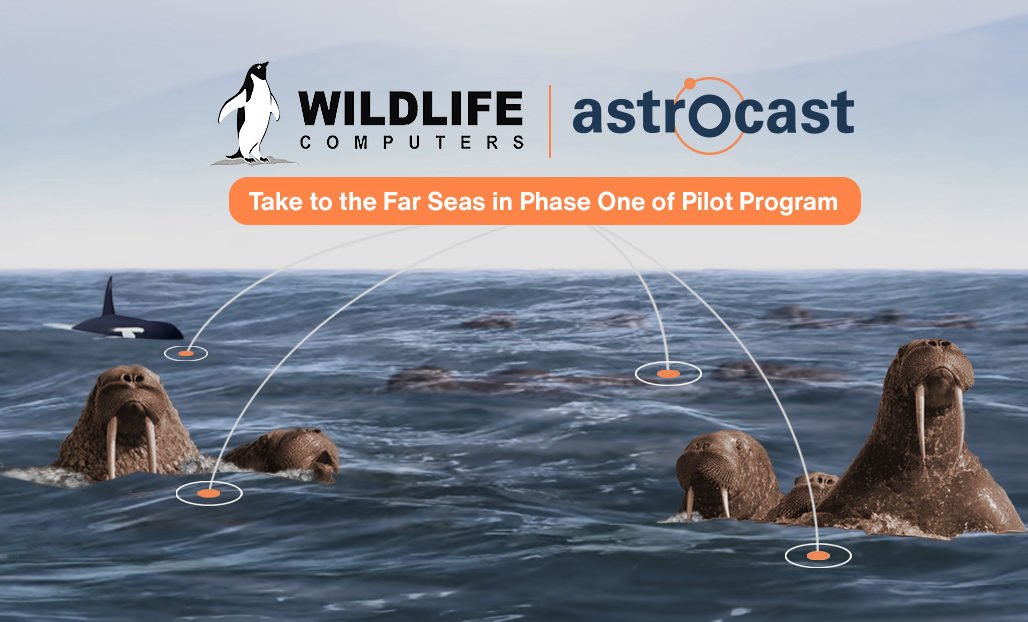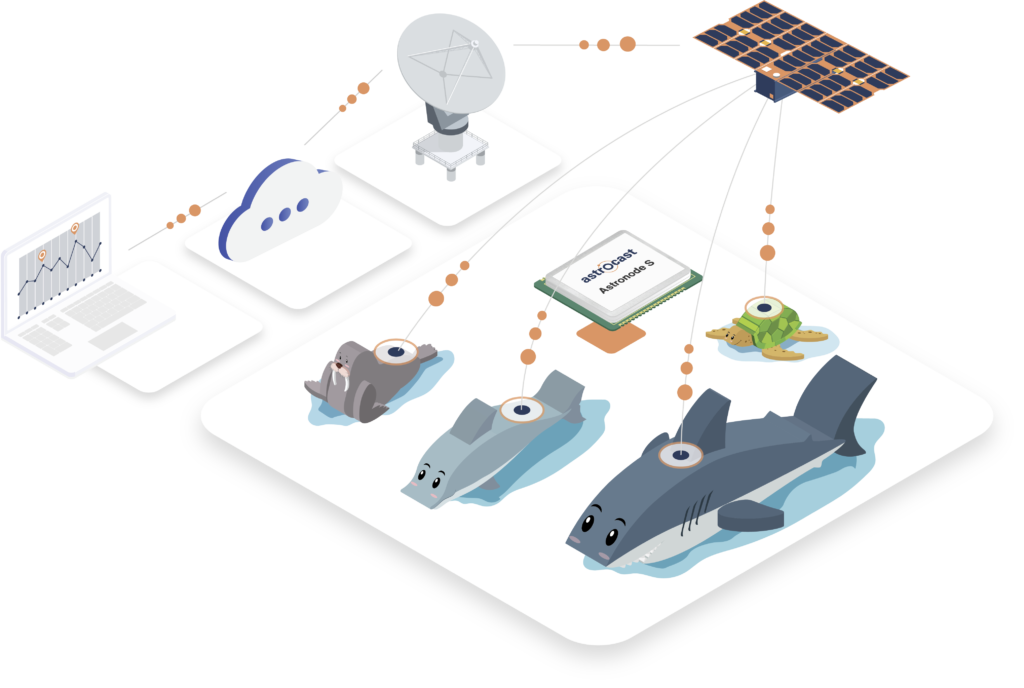What’s in the Astronode Devkit?
26 Jan 2022 | 4 min read
With commercial satellites in orbit, Astrocast offers a Development Kit which enables customers to connect their IoT devices in th...

Wildlife Computers has been in the IoT business for more than 30 years.
IoT devices have expanded throughout the world giving us access to information from the furthest reaches of the earth. Wildlife Computers has been in the IoT business for more than 30 years. They know the powerful insight we can gain when we gather critical data from some of the world’s most challenging locations. Recently, Wildlife Computers joined the Astrocast Pilot Program and began the first phase in aligning the Astrocast IoT Nanosatellite Network with the specific needs and challenges their company faces.
“At Wildlife Computers, we design, manufacture, sell and support a wide variety of telemetry instruments (tags) for wildlife studies. Our tags are deployed on free-ranging animals and track movement and behavior, as well as provide information on the environment the animals are traveling through. The reason “Computers” is part of our name is because we were one of the first animal telemetry companies to use microprocessors in our devices,” said Melinda Holland, CEO of Wildlife Computers.
The key to Wildlife Computers’ success is the ability to send and receive small amounts of data at undetermined intervals. And more importantly, these tags capture more than just animal behavior. Holland clarified, “We make an animal-borne CTD tag. It measures conductivity, temperature, and depth and is used by the oceanographic community to measure the temperature and salinity profiles of the water that the animal is moving through. This is really important right now for scientists studying climate change.”
"This is really important right now for scientists studying climate change.”
Tracking animals in the wild is no easy task.
Tracking animals in the wild is no easy task. Wildlife Computers tracks the behavior of a variety of free-ranging animals including marine mammals, sea turtles, fish, penguins, and even birds weighing as little as 650 grams
Holland went on to explain that climate change isn’t just affecting the ocean’s surface and marine life. “Ocean temperatures are rising and it’s not only the sea surface temperature but it’s the actual heat content. Because the animals dive, you can profile the temperature during a dive and then calculate the energy that the water is actually holding. That is important for things like weather prediction and hurricanes. Conductivity, or salinity, is an important parameter around the high latitudes, the Arctic areas, and the Antarctic areas because that’s a measure of how much the polar ice is melting. Knowing how the seawater has been diluted gives insight into where, when, and how much of the polar ice caps are melting and impacting the ocean. In addition, salinity impacts not only the environment that the animals have to go through, but it drives a lot of the oceanographic processes. These things are of interest to industries, such as shipping and knowing where the currents are going for ocean-bound shipping lanes. If they just move a little bit so they’re not going against the current that can really save a lot of energy. It’s also of interest again for a weather prediction. Energy companies are often interested so they can prepare some of their offshore facilities in case severe weather is coming.”
In order to send telemetry data from the tags to home base so marine scientists, climate scientists, and even shipping companies can leverage the data, Wildlife Computers needs a nanosatellite network that is designed to receive telemetry in the most challenging of environments, in the shortest amount of time, and from anywhere in the world.
Wildlife Computers needs a nanosatellite network that is designed to receive telemetry in the most challenging of environments
What makes our application really challenging is these tags have to be as small as possible so we can put them on the widest variety of species. The goal of many of our customers is to study the behavior of free-ranging animals at sea. In order to monitor true animal behavior, we need to and reduce the impact of the tag as much as possible so it does not bias the data. Many of the animals we are tracking range globally. They won’t necessarily stay in the range of a local ground-based telemetry system or even a cellular network so we need to make small tags that will work around the globe. Finally, since most of our tags go on marine animals that don’t spend a lot of time at the surface, we might only have a few seconds to get data transmitted
Melinda Holland, CEO Wildlife Computers
The Astrocast IoT Nanosatellite Network is a bi-directional, low cost, and low power network that leverages the L Band frequency which enables the use of miniaturized antennas and operates in all weather conditions. For Wildlife Computers, this was an important part of the Astrocast Pilot Program.

“All the telemetry happens as the animal breaks the surface of the water,” Holland explained. “The time it takes to make that connection and download the information needs to happen quickly. What makes Astrocast particularly interesting is the nanosatellite availability, specifically the network coverage from anywhere in the world. You can’t program an animal and tell it to come up to surface when there’s a satellite in view. They aren’t that cooperative.”
Across the globe there is a push to use animals as oceanographic platforms because they’re traveling in areas of high change and they’re responding to those changes in the ocean environment. Holland explained that the Arctic and Antarctic are difficult areas for ship-based measurements or even autonomous underwater vehicles or drones.
“It’s a really rough environment where ice can prevent vessels from traveling freely. Whereas animals, this is where they live. For example, elephant seals will dive up to 2000 meters, which is about a mile deep and you get these beautiful temperature profiles. And this is where Astrocast comes in. One of our technologies has the ability to take a very quick GPS snapshot in less than 50 milliseconds when the animal surfaces. So now we get a nice oceanographic profile and we get a GPS-quality location. Astrocast will receive these data when the animal surfaces and that information will be packaged up and transmitted through the nanosatellite network.”
The Astrocast IoT Nanosatellite Network is a bi-directional, low cost, and low power network that leverages the L Band frequency which enables the use of miniaturized antennas and operates in all weather conditions. For Wildlife Computers, this was an important part of the Astrocast Pilot Program.
“What we were looking for are systems that have high availability, as well as low power, and the ability to pick up transmissions from low-power transmitters without requiring really long handshakes and acknowledgments. With many of the animal applications, it’s a balance of how much information we can get through for the least amount of energy. In the next phase, we’re looking forward to more satellites in the network.”
Another key element to the successful Pilot phase for Wildlife Computers was the ability to work closely with the Astrocast engineering team to meet the specific challenges of their industry.
“What really helped us with the pilot program was that Astrocast’s engineers are open to hearing about our specific requirements. Astrocast was interesting to us because of all the features—it already had a satellite infrastructure going, and it had a developer’s kit. Our interaction with Astrocast and its engineers is very positive. The support is there and the development kit—both for the Wi-Fi and satellite—is there too, well documented, well presented, and written as such that it was easy to implement the different microprocessors. We set up the developer’s kit within 24 hours and within two weeks had everything up and running. The support was excellent. And the fact that Astrocast already has a satellite constellation and some of the infrastructure in place, so we could actually do a pilot study, was very important.”
Melinda Holland, CEO of Wildlife Computers.